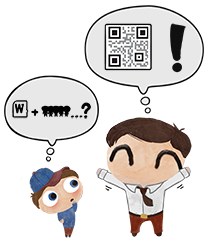 Your talk went down very well, you got rapturous applause, and some delegates even began to stand…there were murmurings of a Nobel Prize. Now, the hard bit, all those eager students in the front row want a copy of your slides so they can emulate your greatness, or more likely nitpick and point out the flaws in your otherwise flawless logic. You really don’t want the inconvenience of collecting email addresses or worse swapping business cards. So, what’s the easy option for a busy speaker one the conference circuit? QR codes. Obviously.
Your talk went down very well, you got rapturous applause, and some delegates even began to stand…there were murmurings of a Nobel Prize. Now, the hard bit, all those eager students in the front row want a copy of your slides so they can emulate your greatness, or more likely nitpick and point out the flaws in your otherwise flawless logic. You really don’t want the inconvenience of collecting email addresses or worse swapping business cards. So, what’s the easy option for a busy speaker one the conference circuit? QR codes. Obviously.
But, isn’t creating QR codes for your documents a painful process that will add precious minutes to your speech preparation time? Not necessarily. A new service with the painful name of TagMyDoc allows you to add a tag to a document which can be scanned and retrieved as a virtual copy via a QR code, which you would, of course, display at the end of your talk so that all those delegates can scan it with their iPhones. The system supports the following file types: jpg, tiff, png, bmp, gif, doc, docx, ppt, pptx and pdf.
There is the inevitable mobile app – ScanMyDoc, which is the only TagMyDoc-ready QR reader at the moment, which also lets you sync ScanMyDoc with your TagMyDoc account and manage your scanned documents.
There is a Microsoft Office Add-in for Word that lets you tag and save your document directly and a similar Add-in for Microsoft PowerPoint, which lets you tag and save your presentation directly from Microsoft PowerPoint without ever leaving the application.
In a sense, TagMyDoc is the reverse process of printing – When you print, your document goes from a virtual form to a hard copy. This approach means a recipient can get a virtual copy of a document or presentation from a hard-copy form (print or on your lecture screen).